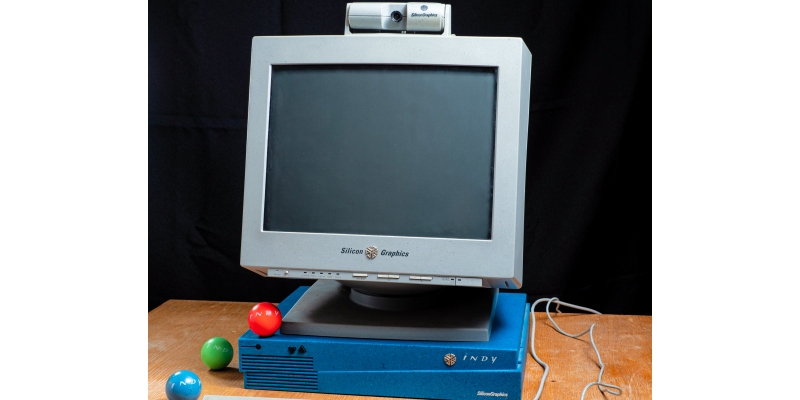
SGI Indy Workstation
“Who dunnit?” Crimewave hits the Department
The department suffered a serious burglary as the Indies arrived. The machines were in the hardware lab awaiting installation. One evening the room was broken into and all the memory from all the machines was stolen!
These machines replaced the Sun 3 workstations on each person’s desk. The sturdy, electric-blue coloured "pizza box" chassis is comparable to a contemporary small desktop PC, and is intended to fit underneath a large CRT monitor. They were much faster than the SUN workstations. They are reported to be the one of the first workstions to come with a camera for ‘web chat’. It was called Indycam. These were never enabled in the Department as the network could not manage the amount of data produced by the camera.
The Indies were incredibly robust machines. Jim Austin used one every day, and it ran for two years without needing a re-boot. It was one program that crashed the machine (ghoscript) that forced a re-boot.
Indy competed with Windows and Macintosh, including using their files and running their applications via software emulation. One commentator remarked that using Quorum's Latitude technology, "Indy blows Macs away using the Mac's own software", also expressing similar sentiments about Windows support provided by SoftPC.
Related links
Indies used the MIPS R3000 processor, a breakthrough in processor design as it was designed in record time compared to the Motorola 68000 used in the SUN.
The base Indy model was launched in July 1993 at £4,000 (equivalent to about £7,500 in 2022), without a hard drive, or diskless, and is intended for networked use. The model with a 2GB hard drive was launched at £6,000.
In March 1994, the series was refreshed with a new 150 MHz R4400 CPU.
- the low end model has 8-bit colour, 32 MB RAM, 535 MB hard drive, and 16-inch 1280 x 1024 monitor for £12,500 (equivalent to £22,500 in 2022)
- the high end has 24-bit colour, 64 MB RAM, 1 GB hard drive for £18,300 (equivalent to £33,500 in 2022).
Sales of low-cost high-performance workstations were projected to triple from 1994 to 1999, and competition for that market increased between Sun and SGI.
The Indy is the first computer to have a standard video camera, and the first SGI computer to have standard video inputs. Each Indy has an amateur quality composite, S-Video, and digital video input built into the motherboard, which collectively are known as "Vino" (video input, no output) video. The digital input is a SGI Digital Video Interface (proprietary D-sub connector) with a rectangular high density array of 60 pins, and is used by the IndyCam. The connector incorporates two digital video ports, but only uses the first one for input on the Indy.
The IndyCam is a small fixed-focus digital video camera, co-developed by SGI and Teleview Research. It can be mounted above the monitor, or hand-held. It is one of the first desktop video cameras and the first to come standard on a computer. With the bundled software, it can be used for video conferencing, video editing, or video email.
At launch, SGI said it expected to sell $1 billion worth of Indy units. Byte magazine said in September 1993 that Apple and SGI were trailblazers by setting audio and video as default features of the Macintosh and Indy desktop PCs, which "could change the way businesspeople communicate". In 1994, Byte called the new Indy "low on price but high on graphics performance", noting its interoperability with Windows and Macintosh.